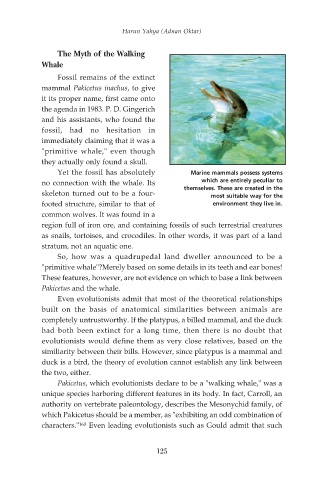Page 127 - Darwinism Refuted
P. 127
Harun Yahya (Adnan Oktar)
The Myth of the Walking
Whale
Fossil remains of the extinct
mammal Pakicetus inachus, to give
it its proper name, first came onto
the agenda in 1983. P. D. Gingerich
and his assistants, who found the
fossil, had no hesitation in
immediately claiming that it was a
"primitive whale," even though
they actually only found a skull.
Yet the fossil has absolutely Marine mammals possess systems
which are entirely peculiar to
no connection with the whale. Its
themselves. These are created in the
skeleton turned out to be a four- most suitable way for the
footed structure, similar to that of environment they live in.
common wolves. It was found in a
region full of iron ore, and containing fossils of such terrestrial creatures
as snails, tortoises, and crocodiles. In other words, it was part of a land
stratum, not an aquatic one.
So, how was a quadrupedal land dweller announced to be a
"primitive whale"?Merely based on some details in its teeth and ear bones!
These features, however, are not evidence on which to base a link between
Pakicetus and the whale.
Even evolutionists admit that most of the theoretical relationships
built on the basis of anatomical similarities between animals are
completely untrustworthy. If the platypus, a billed mammal, and the duck
had both been extinct for a long time, then there is no doubt that
evolutionists would define them as very close relatives, based on the
similiarity between their bills. However, since platypus is a mammal and
duck is a bird, the theory of evolution cannot establish any link between
the two, either.
Pakicetus, which evolutionists declare to be a "walking whale," was a
unique species harboring different features in its body. In fact, Carroll, an
authority on vertebrate paleontology, describes the Mesonychid family, of
which Pakicetus should be a member, as "exhibiting an odd combination of
characters." 160 Even leading evolutionists such as Gould admit that such
125

